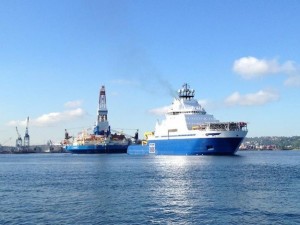Shell Fails To Get Its Arctic Oil Spill Barge Certified By The Coast Guard
 In the event of an offshore oil spill in the Arctic, Shell has previously admitted it can only “encounter” most of the oil in the frigid, pristine waters — not clean it up. However, it may lack the resources to do even that.
In the event of an offshore oil spill in the Arctic, Shell has previously admitted it can only “encounter” most of the oil in the frigid, pristine waters — not clean it up. However, it may lack the resources to do even that.As Shell’s fleet sails north to prepare offshore drilling in Arctic waters, Shell’s oil spill recovery barge, the Arctic Challenger, remains docked in northern Washington after failing to receive Coast Guard certification. The Los Angeles Times reports:
The delay in certification adds another notch of uncertainty to Shell’s narrow window for operations in the Arctic, which already is tight because drilling must halt by September in the Chukchi Sea and by October in the Beaufort Sea to avoid the dangerous advance of sea ice that comes with winter. Though drilling initially was scheduled to commence by mid-July, unusually heavy sea ice from the past winter has postponed that, probably until the first week of August.
The federal Bureau of Safety and Environmental Enforcement has said it will not issue final drilling permits until the Arctic Challenger receives final Coast Guard certification.
The Coast Guard raised concerns about the fire protection system, electrical wiring, and piping on the 37-year old vessel, as well as its ability to withstand a “100-year storm” — an event with a 1 percent likelihood of occurring over the course of a century. Shell operators contend that the Coast Guard requirement for the barge to withstand a 100-year storm is unnecessary, believing the ability to withstand a 10-year storm is sufficient.
Just last year, Alaska was hit with “of the most severe Bering Sea storms on record,” only a week after the end of Shell’s proposed Beaufort drilling season.
The barge, languishing in northern Washington for the next three weeks, serves to transport oil containment equipment to any of the five exploration wells Shell intends to drill. The absence of this vessel as Shell’s fleet treks north is especially alarming given the lack of infrastructure in Northern Alaska available to respond to a spill, and Shell’s safety violations in while drilling in the North Sea.
At a congressional hearing in 2011, Commandant Robert Papp, head of the U.S. Coast Guard, expressed his skepticism in the Coast Guard’s ability to respond effectively to an oil spill in the Arctic Ocean, saying “if [a spill] were to happen off the North Slope of Alaska, we’d have nothing. We’re starting from ground zero today.”
As detailed in a report from the Center for American Progress, the lack of infrastructure in Northern Alaska necessary to respond to a spill is staggering. The nearest major port is over 1,000 miles away from the drill sites and “there are no roads whatsoever connecting communities along the North Slope of Alaska.”
In an environment as pristine, yet unpredictable, as the Arctic, Shell must be prepared for all possibilities. It is not enough to hope that containment is unnecessary, and if Shell rushes their processes, they may well find themselves unprepared for the consequences.
You can return to the main Market News page, or press the Back button on your browser.

